Classical blues pioneers: Ma Rainey and her Georgia Jazz Band pose for a studio group shot in the mid-1920s. From right: ‘Gabriel’, Albert Wynn, Dave Nelson, Ma Rainey, Ed Pollack and Thomas A Dorsey. (Photo: JP Jazz Archive/Redferns)
“Contemporary films continue to place Black women in two categories: mammy or slut. And, occasionally a combination of the two.”
— bell hooks, “Selling Hot Pussy” in Black Looks: Race and Representation, 1992
“My girlfriends are all beautiful. I like ugly men. I’m not pretty but I’ve got sexual appeal. I love strong women. Soft women are the worst skelms.” — Heather Robertson: “In Search of Brenda [Fassie]”, Tribute Magazine, June, 1994
“Henry Miller insisted on what Ma Rainey, Bessie Smith and Lucille Bogan have said before. That sexual freedom was as necessary as economic freedom. That the volcanic force of an orgasm might be compared justly to an uprising. But when the white boy said it, the world listened.” — Saidiya Hartman, Wayward Lives, Beautiful Experiments, 2019
Yonks ago and amid one of capitalism’s silliest decades, in which Cowboy Ronnie Reagan and union-bashing Maggie Thatcher stomped across the globe evangelising the virtues of the free market, August Wilson unleashed a stage play about the most unlikely subject.
The Pittsburgh native released the play — now a Netflix film directed by George C Wolfe with the brand-name backing of Denzel Washington — about one of the not only long-forgotten but erased women who was one of the pioneers of what is called “classical” blues music, Gertrude “Madame” Rainey.
A Chicago native, “Ma” Rainey is now, fashionably, recognised for being a lightning rod for several contemporary issues: she was a big-bodied woman with a solid back, big black rolling hips, a razor blade for a tongue, independent and openly queer as fuck. What is not said enough of her, if at all, is that she was not only “the mother of the blues”, but among the first to create “modern”, that is to say, discernibly American, blues music.
The distinction is important: until the early 1900s, the sound, style and vocal heart of the blues that issued out of field folk music, as well as the Negro spirituals (to South African ears: amahubo) performed by enslaved Africans and their descendants long after slavery was legally outlawed, was African in all intents and modalities.
In his social and anthropological study, Blues People: Negro Music in White America (Payback Press, 1963), a look at how New Africans created contemporary music (blues, jazz, ragtag, boogie-woogie, riddim ’n blues, gospel, soul and, by extension, all their tributary chirrun, like rock, folk, country, disco and hip-hop, et cetera), Amiri Baraka, then known as LeRoi Jones, credits Ma Rainey’s musical stylings, alone, as “the link, the bridge” between the “primitive” and “classical” blues.
Ma Rainey’s import to music performance, Black feminism, queer politics and camp aesthetics, to raw-kin-roll, to musical theatre, to discord and discourse about notions of Black beauty, heck … to the sort of punk poetry the likes of Koleka Putuma, Jessica Care Moore, Staceyann Chin, and even The Dixie Chicks derive pleasure in, cannot be overstated.
 Ma Rainey’s Black Bottom stars Viola Davis as “Ma”. (Netflix)
Ma Rainey’s Black Bottom stars Viola Davis as “Ma”. (Netflix)
Angela Davis reminds us in her seminal text Blues Legacies and Black Feminism (Vintage Books, 1999), an inter- and intratextual lyrical appraisal of the art and sexualities of “problematic” women Ma Rainey, Bessie Smith and Billie Holiday, that women performers — Ma Rainey at the forefront — were “for an important while, the first to be recorded and sold” before the industry turned to men, “shutting women out once and for all”.
Davis’s — and before her, Wilson’s — intervention, even though it’s thin on the life behind the art, is instructive, not least because Ma Rainey has also been given the heave-ho by men and women, radical nationalists and feminists alike, Black and White.
Even Davis cared not to explore this musical and sexual pioneer as a solo subject but mainly, together with Rainey’s protégé, Bessie Smith, as the intellectual back-up squad to the most famous of all blues interpreters, Billie Holiday.
A recent compendium of “women who rock”, compiled by Evelyn McDonnell, gives a raft of subversive women performers more than their critical 15 minutes of fame. It juices them with love.
From Bessie Smith to Björk, Celia Cruz to Amy Winehouse, Angélique Kidjo to PJ Harvey, a slew of — to use the Miami rapper Trina’s adage, which the introduction samples — “the baddest bitches” are accorded their due critical riffs, love, and squeeze-hugs. And yet the “baddest bitch” of them all is wistfully denied her mojo. Oh well, neither are Big Mama Thornton, Miriam Makeba, or Busi Mhlongo, all of whom had recorded impact on Western popular song, given so much as a scant sniff.
Quibbling aside, we now appreciate why Wilson must have surely been inspired, provoked and haunted by this historical background, and the singular backbeat Ma Rainey played in it before getting erased from this narrative, to write, direct and produce in 1982 the now classic Ma Rainey’s Black Bottom.
The play is built around, and is a paean to, Ma Rainey’s most famous song, out of the more than 92 recordings in her discography, as well as to the composer, per se.
It premiered in Connecticut in 1984, going as far as winning Wilson, “the stage godfather of the Black working-class communities”, a Tony award in the then still racist genre.
Almost 40 years later Wilson’s play has, in the resurrectionist and second iteration of civil rights across the globe led by Black women, received its cinematic dues.
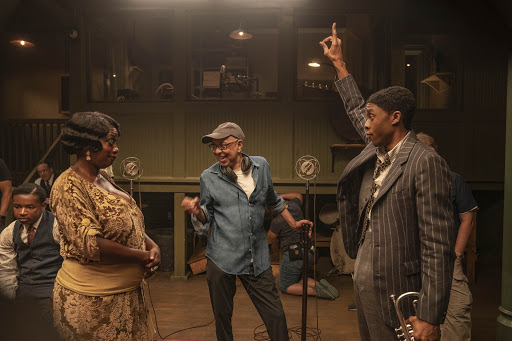 Viola Davis pictured on set with George C Wolfe and the late Chadwick Boseman. (Netflix)
Viola Davis pictured on set with George C Wolfe and the late Chadwick Boseman. (Netflix)
Helmed by one of the most gifted stage directors of the last half a century, George C Wolfe, Ma Rainey’s Black Bottom drops in quite a fertile atmosphere.
It is not the first blues or shrouded-in-the-subversive blues film. One of “Ma’s” midnight blue children, Tina Turner, had her life and work told cinematically in the 1993 picture, What’s Love Got To Do With It.
Both Billie Holiday and Bessie Smith have had their cinematic dues served, by Lady Sings the Blues in 1972, and Bessie in 2005, the latter directed by Dee Rees.
Not only is Ma Rainey not the first film conceived to tell either the life or story of a pioneer female icon’s “baddest ass song”, it is also not the first major stage-to-screen adaptation.
The same Wilson’s Fences had been brilliantly adapted by Denzel Washington, the force behind adapting the playwright’s classics into film, and Hollywood has blessed us with Amadeus, and Tennessee Williams’s A Streetcar Named Desire, which was partly filmed on stage.
Just thinking of these films, my mind plays wicked games with me: I can’t help but wonder how the life or work of someone such as Edith Piaf, or say, Dolly Rathebe, perhaps scripted around the making of her Jürgen Schadeberg-shot bikini Drum cover (well, what about Aretha Franklin’s iconic recording sessions with Reverend Cleveland?) transfused into film, even though none of them began life in theatre. But that’s just me.
Returning to Ma Rainey: clearly not all stage pieces or, perhaps, not all lives, translate well onto the screen.
The film is a mess.
A glorious, campy, emotionally dramatic and well-intentioned mess. And yet a mess all the same. And much of the blame should be laid squarely on Wolfe’s shoulders.
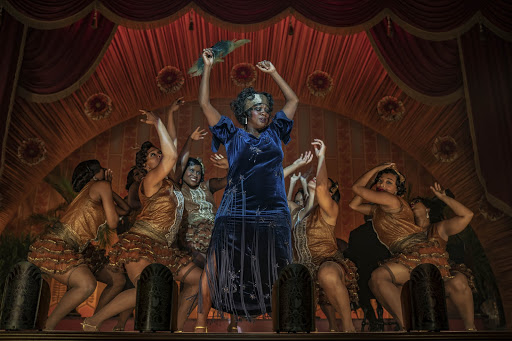 The establishing shot, also used as a trailer for the film, is a thing of gorgeous danger, hyp-“naughtic” trance and sensuality. (Netflix)
The establishing shot, also used as a trailer for the film, is a thing of gorgeous danger, hyp-“naughtic” trance and sensuality. (Netflix)
Wolfe succeeded in resurrecting the life, nay the name of Gertrude “Ma” Rainey, and went on to provide us with a deeply dissatisfying film. Not only that: he failed rather dramatically in telling the life of such a well-rounded and larger-than-life figure, artist, woman … Black woman. Wolfe failed not because he is a first-time film director but because he let his theatre grounding restrict the potentially brilliant auteur in him.
It all starts promisingly, entrancing even. The establishing shots, a mélange of tight frames that, at one point, invites the viewer to a focused attention on “Ma” on stage, while contrasting that with a clip of hard-toiling Negro men in factories.
The film’s overall palette, especially in the opening shot — a blend of scarlet sepia and reds, splashed with a kind of silver gelatin sheen — is gorgeous and a relief from plantation monochrome of blacks, greys and whites.
It is in these lush but restrained colours that the director bathes perhaps his most gorgeous promise, for it will remain that: a promise.
The promise is suggested when the director pumps up the sweaty full-on rolling blues “vuligate” dance sequence on stage.
The establishing shot, also used as a trailer for the film, is a thing of gorgeous danger, hyp-“naughtic” trance and sensuality. Resplendent in shimmering purples and “blues”, “Ma” is shot belting gut bucket blues, amid strobe lights, while a bevy of full-bodied female dancers shimmy and ramp-shake their collective nyash, in a truly transgressive sequence.
They are all “Ma’s” pretty young thangs. They could as well be “babes” in the Ancient Magic Queen’s harem, had Negro women had the legal “pleasure”, fortune and power to do so, as opposed to trading in plum-ripe Chocolate Negro, Mulatto Negro and Creole-Latino flesh in underground brothels. Beyoncé is not the first and will not be the last to pack her stage shows with fit and striking Black women.
Whereas Bey’s choreography sisterhood is firm, athletically enhanced, abs and all, ultimately lifeless, Ma Rainey’s women are voluptuous, sensual, playful and bring high voltage to “Ma’s” grotesque-ish but regal, camp and feline power.
But then, in typical Negro showbiz herstory, the director had to have nearly all of those dancers yellow-skinned. The only chocolate sister in the dance troupe is hidden in the back row. When she appears, the lighting is yellowed a bit.
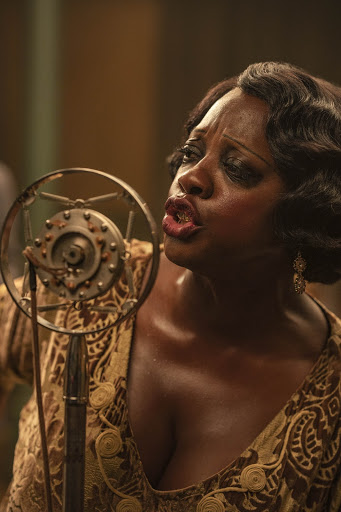 Ma Rainey’s song Black Bottom is considered among the “baddest” in a catalog of over 90 recordings. (Netflix)
Ma Rainey’s song Black Bottom is considered among the “baddest” in a catalog of over 90 recordings. (Netflix)
The film is about a song titled Black Bottom, which is a potentially charged subject not only in the “Jazz Age” Amerikkka, but the world over, today still.
There is nothing whiteness, America and Hollywood (and Black men!) — the entire contemporary culture and its hyper capitalism levers — find more commodifiable than a Black woman’s ass. And yet nothing is as troubled, fearsome, yearned for and expendable.
That is one aspect of the film the director could have — excuse the pun — made a meal of. Too bad he chose to sit on that Black bottom.
The entire historical radical Negro house of cards edifice collapses when the director simply transferred a stage play onto screen, as is, substituting one medium for another with no discernible understanding, at least on screen, that each medium is inherently different from the other.
Sure, it’s an adaptation, but movies are a totally different medium: you don’t have to stay artistically faithful to the original text.
Even if compelled to stay authentic — which, of course, is both a folly and inauthentic in itself in matters of art interpretation — a director retains improvisational rights.
Given a choice, such an adaptation has a creative responsibility to privilege movie-making, a totally singular form of entertainment, above the original source. But that’s just the beginning: a conceptual failure.
It gets worse.
Ma Rainey’s storyline — a woman’s self-affirmation in a patriarchal and racist music and performance industry, and society — is rendered thin.
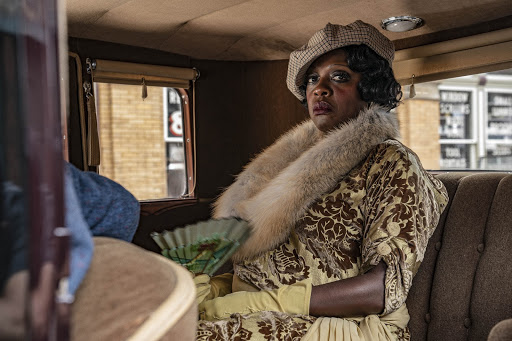 Viola Davis struggles to animate the “ flattened” character handed to her in Ma Rainey, in which “Ma”’s badassery is often reduced to a sulk. (Netflix)
Viola Davis struggles to animate the “ flattened” character handed to her in Ma Rainey, in which “Ma”’s badassery is often reduced to a sulk. (Netflix)
Nothing feels real here: Ma Rainey’s queerness is tick-boxed, her beauty routine never even touched, family relations only hinted at. She’s made into a cardboard caricature of an Angry Black Woman. A potential, powerful minefield is reduced to a sulk.
Instead of exploring the contradictions and doubt that affects all artists, including those who proceed to take on powerful oppressive forces, the film opts for journalistic reportage, pummelling us with facts. In fact, one fact: sulking.
Other than Levee, the young, gifted and Black, ambitious, deeply tragic and ultimately erratic trumpeter channelled by the late Chadwick Boseman, none of Ma Rainey’s characters is fully fleshed out at all, and the setting, an underground recording studio, is claustrophobic.
In the film’s most tense and heartbreaking moment, Levee explains, in an impassioned recollection, his code-switching approach to white folks whom he has reason to hate with all the drops in his blood, yet grins at.
He tells the story of eight white men who assaulted and had their filthy ways with his mother. He was eight.
But this is done without the narrative big picture of a James Baldwin recalling his time as a child-preacher in Harlem storefront churches. Or the cinematic creativity in which Quentin Tarantino fleshes out the back story of O-Ren Ishiii, the imperial, cold-hearted mob boss whose mother was raped by a bunch of brutes in Kill Bill, lending gravitas to how she later became so embittered. Nah: in George C Wolfe’s rendering, or is it August Wilson’s, Levee’s flashback tale lapses into a dirge. You feel pity for him. You are never afraid of him. Even if he sure will knife you in cold blood.
The overall narrative, if one may refer to it as such, says pretty much nothing new about Ma Rainey the woman. It says nothing new about the blues as a music form, apart from reluctant gesturing at the life out on the Chicago streets the director feels deserves exploring.
It is as though the director is avoiding preaching to the converted on how social life was in American cities for “Negroes” in the 1920s.
Fair enough. It is also true, the adage that there is nothing new under the sun. However there’s a way of enriching what we know with inspired art, and telling the current generation stories in a looser narrative that cares about movie-making as an art form.
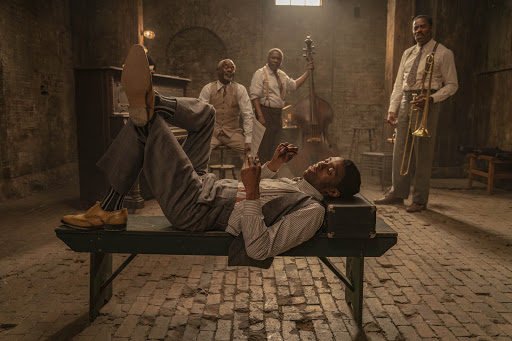 Boseman invites pity more than he does fear as the highly-strung Levee, Ma Rainey’s trumpeter. (Netflix)
Boseman invites pity more than he does fear as the highly-strung Levee, Ma Rainey’s trumpeter. (Netflix)
Wolfe’s reticence at cinematic pedagogy serves as prohibition, denial, erasure. The story swerves around and avoids peering into the lives of women then, least of all its main character.
Viola Davis tries her best to capture mostly “Ma’s” mannerisms, a Stanislavski method skill, but she simply could not rescue a flattened character.
Davis’s “Ma” is all hand flailing, with no interiority at all. We don’t know when she is happy, and even when she is feeling sexy she appears lecherous.
We don’t know when she’s sad because her sadness is erased by an omnipresent anger: anger that does not play itself out to the end: harmless anger, and not Black radical anger, mainly because she ends up backtracking in all the instances her anger should have either burned her or saved her from her asphyxiating condition as a Black person, a woman, artist and queer. Thus her anger is spliced into nothing but a series of framed performative threats.
Although the film was a big letdown for me, I must say director George C Wolfe, a queer man and gifted playwright, truly excelled in the opening sequence, which matches the opening soul/blues club scene in Will Smith-Michael Mann’s Ali: the Biopic.
The inverse great thing I take from the film is that there’s still a huge opportunity for a truly bold filmmaker to throw fire to the establishment, and make a complex, unhinged, fuller, dynamic film that goes beyond titillation and ideological gesturing to the current moment.
Bongani Madondo is the contributing editor of I’m Not Your Weekend Special: Portraits of the Life, Style & Politics of Brenda Fassie and the author of Hot Type and Sigh, the Beloved Country